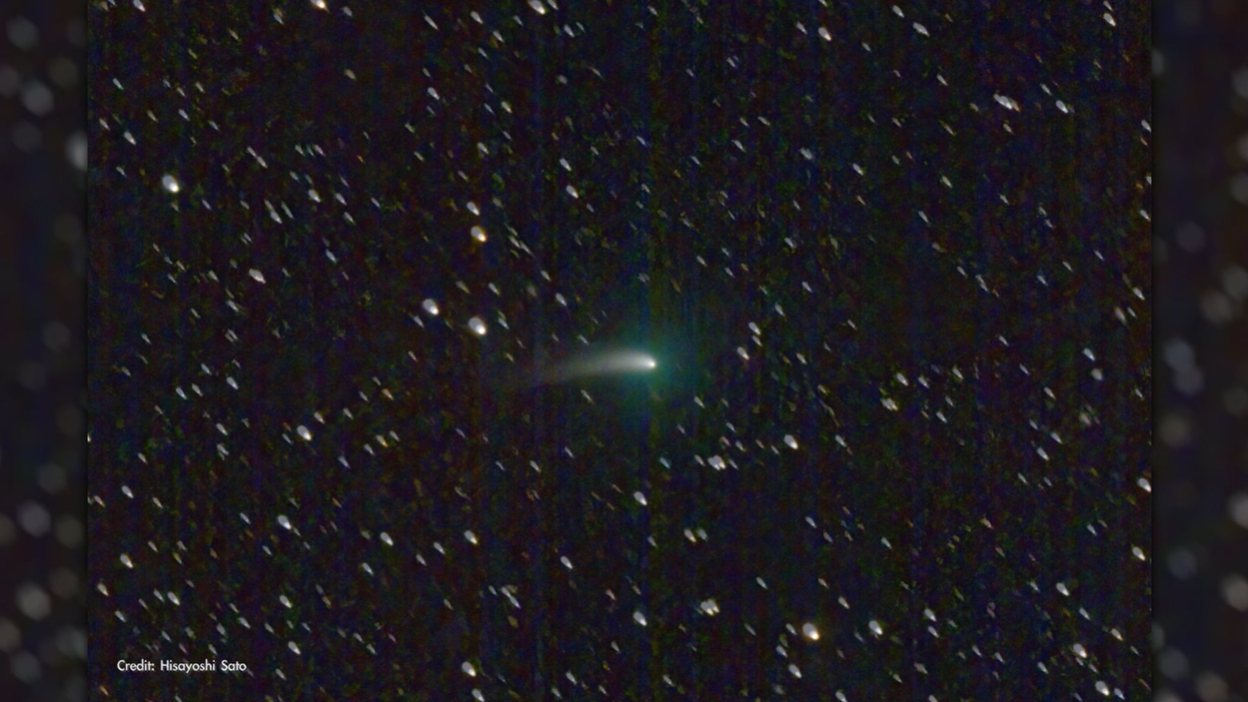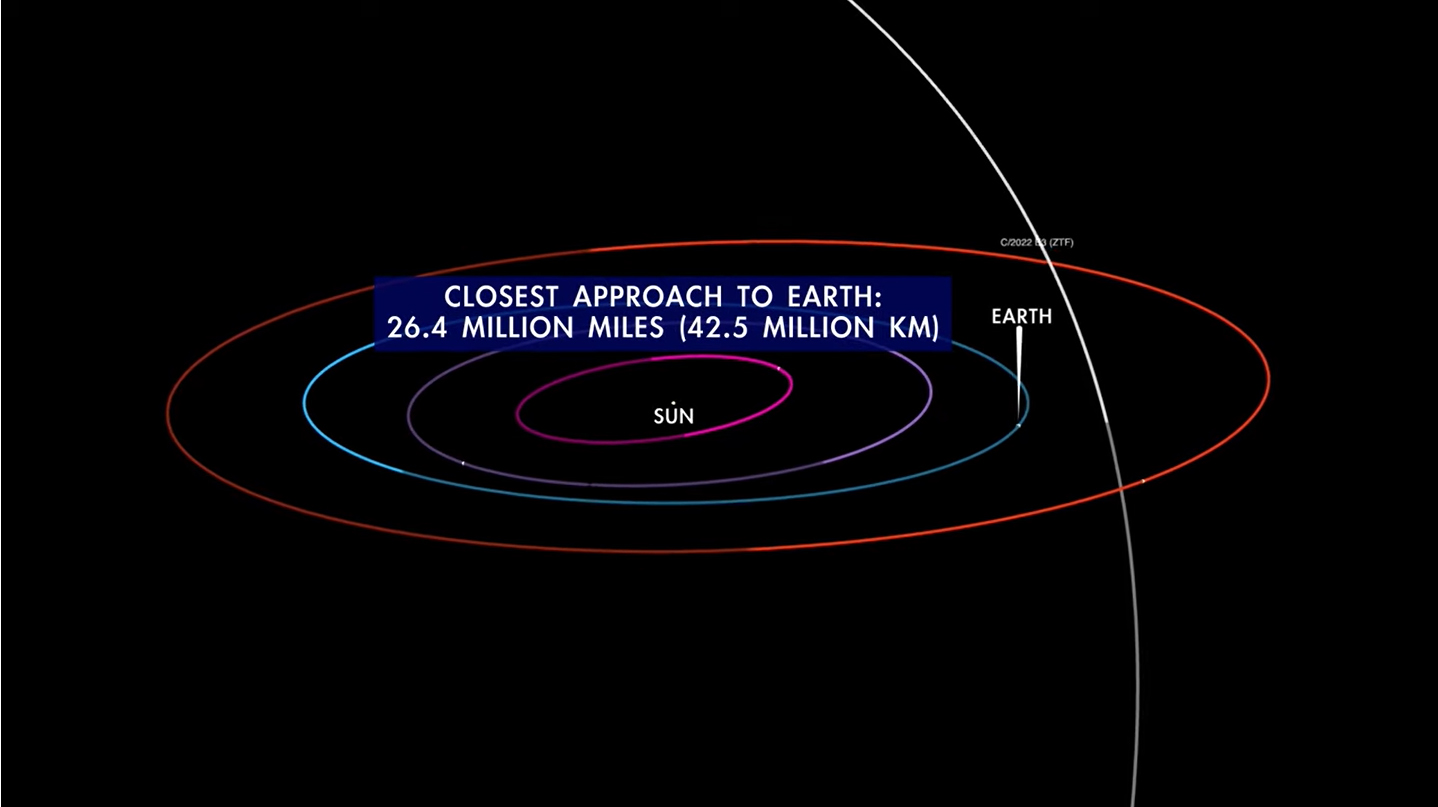Possible naked-eye comet will visit Earth for 1st time since Neanderthals in 2023
The comet C/2022 E3 (ZTF) could be bright enough to be spotted with the naked eye as it passes the sun and Earth at the end of the first month of 2023.
At the start of 2023 Earth will be visited by a newly discovered comet that may just be bright enough to be spotted with the naked eye.
The comet, named C/2022 E3 (ZTF), is currently passing through the inner solar system. It will make its closest approach to the sun, or perihelion, on Jan. 12, and will then whip past Earth making its closest passage of our planet, its perigee, between Feb. 1 and Feb. 2.
If the comet continues to brighten as it currently is, it could be visible in dark skies with the naked eye. This is difficult to predict for comets, but even if C/2022 E3 (ZTF) does fade it should still be visible with binoculars or a telescope for a number of days around its close approach.
Related: The 12 best night sky events to see in 2023


Looking for a telescope to see the planets or anything else in the December night sky? We recommend the Celestron Astro Fi 102 as the top pick in our best beginner's telescope guide.
According to NASA, observers in the Northern Hemisphere will be able to find the comet in the morning sky, as it moves in the direction of the northwest during January. C/2022 E3 (ZTF) will become visible for observers in the Southern Hemisphere in early February 2023.
Observers should look for C/2022 E3 (ZTF) when the moon is dim in the sky, with the new moon on Jan. 21 offering such an opportunity, weather permitting. According to the website Starlust, the comet will be in the Camelopardalis constellation during its close approach.
If you’re hoping to observe C/2022 E3 (ZTF), our guides for the best telescopes and best binoculars are a great place to start. If you’re looking to snap photos of the night sky, check out our guide on how to photograph the moon, as well our best cameras for astrophotography and best lenses for astrophotography.
Get the Space.com Newsletter
Breaking space news, the latest updates on rocket launches, skywatching events and more!
According to NASA Jet Propulsion Laboratory (JPL), the comet has a period of around 50,000 years. This means that prior to it coming to within around 100 million miles (160 million kilometers) of the sun on Jan. 12 and 26 million miles (42 million kilometers) of Earth on Feb. 2, the last time it came so close was during the Upper Paleolithic period on Earth.

That means the last humans that could have spotted C/2022 E3 (ZTF) were early homo sapiens alive during the last glacial period or "ice age." So, too, could some say of the last Neanderthals, as that species became extinct around 10,000 years after the last perihelion of C/2022 E3 (ZTF).
Of course, the Neanderthals and early humans wouldn't have known what C/2022 E3 (ZTF) was, and the comet was identified much more recently than the last ice age. The comet was spotted by the wide-field survey camera at the Zwicky Transient Facility in early March 2022.
Initially appearing to be an asteroid, C/2022 E3 (ZTF) which was inside the orbit of Jupiter at the time, soon began to brighten as comets do. At the time of its discovery, C/2022 E3 (ZTF) had a magnitude of 17.3, brightening to a magnitude 10 in November, and expected to eventually reach magnitude 6.
Current images of C/2022 E3 (ZTF) show its coma, a surrounding halo of gas and dust, glowing with a greenish hue and a long but faint cometary tail extending from its main body.
Editor’s Note: If you snap the comet C/2022 E3 (ZTF), and would like to share it with Space.com’s readers, send your photo(s), comments, and your name and location to spacephotos@space.com.
Follow us on Twitter @Spacedotcom or on Facebook.
Join our Space Forums to keep talking space on the latest missions, night sky and more! And if you have a news tip, correction or comment, let us know at: community@space.com.

Robert Lea is a science journalist in the U.K. whose articles have been published in Physics World, New Scientist, Astronomy Magazine, All About Space, Newsweek and ZME Science. He also writes about science communication for Elsevier and the European Journal of Physics. Rob holds a bachelor of science degree in physics and astronomy from the U.K.’s Open University. Follow him on Twitter @sciencef1rst.
-
rod Early morning 24-Dec, I did view this comet using my 90-mm refractor telescope. Easy to locate using the Telrad that morning.Reply
Observed 0430-0530 EST. I was able to view ZTF C/2022 E3 this morning using my 90-mm refractor with TeleVue 32-mm plossl and TeleVue 14-mm Delos eyepieces. 31-71x views. Distinct stubby fan shape tail with coma. The star TYC2040-488-1 about 9 arcminute angular separation from the comet and 8.15 apparent magnitude. Starry Night shows the comet 8.59, Stellarium 1.1 shows 8.59 apparent magnitude. These estimates looked good for brightness of C/2022 E3 ZTF.
The comet was in Corona Borealis. If clouds clear up, I may attempt another observation. The January 2023 issue of Sky & Telescope beginning on page 48 has a report for viewing the comet too and position changes coming. Will have to wait and see just how bright this comet gets. -
rod I plan to view again near 0500 tomorrow morning (Friday) or same time Saturday morning. Perhaps another observation post is coming :)Reply









